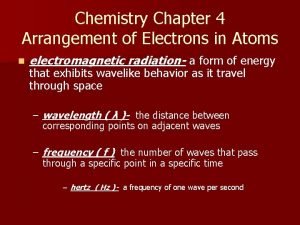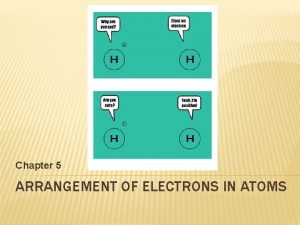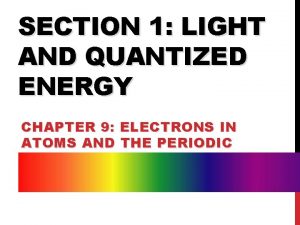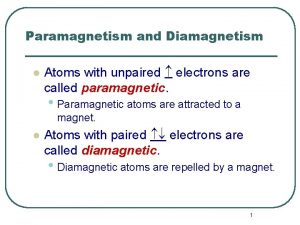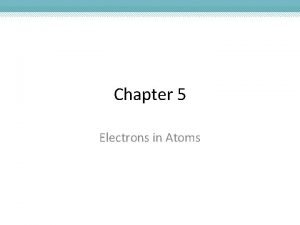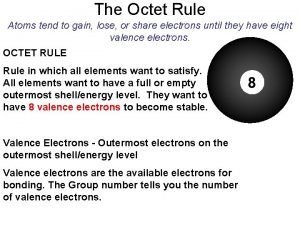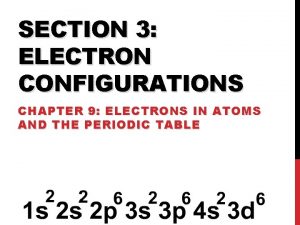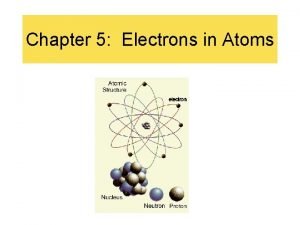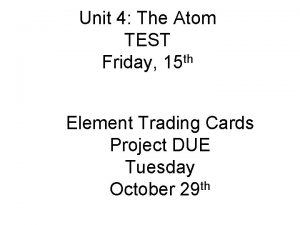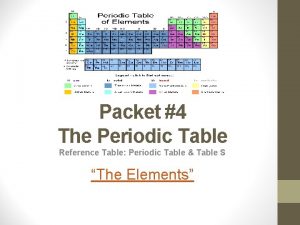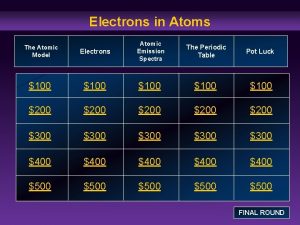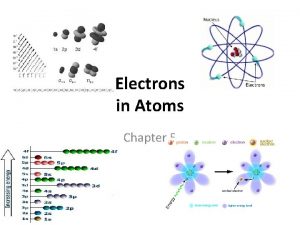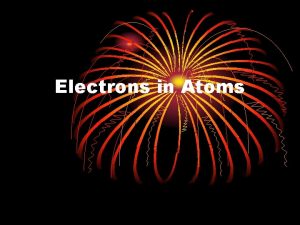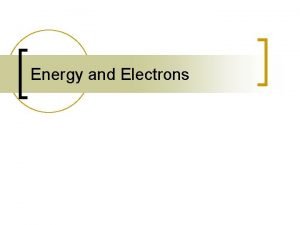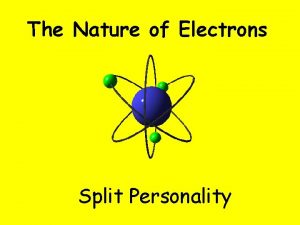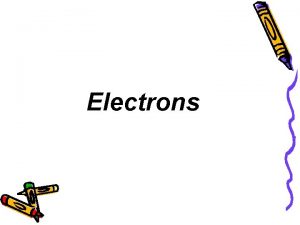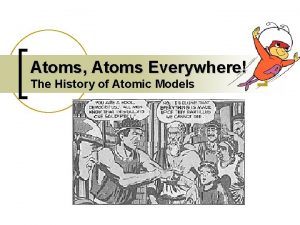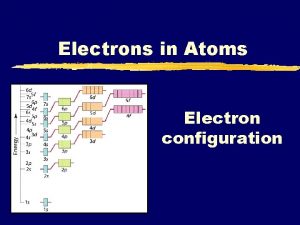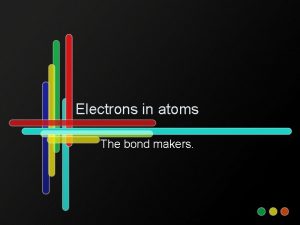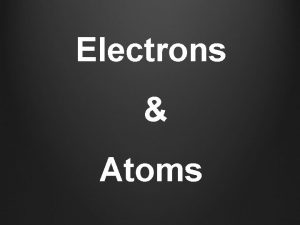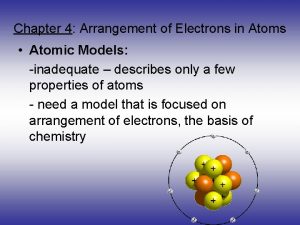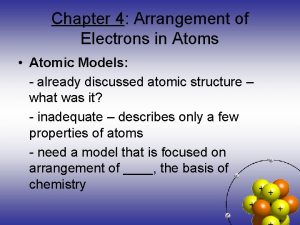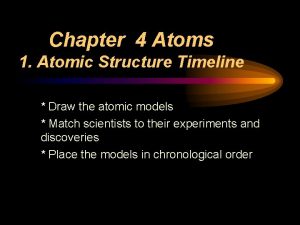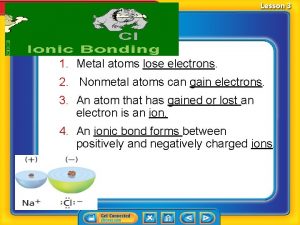Electrons in Atoms Chapter 5 Atomic Timeline Models



























- Slides: 27

Electrons in Atoms Chapter 5

Atomic Timeline

Models of the Atom Rutherford’s atomic model could not explain the chemical and physical properties of elements Bohr proposed that an electron is found only in specific circular paths, or orbits, around the nucleus o Each possible electron orbit has a fixed energy called energy levels Quantum of energy is the amount of energy required to move an electron from one energy level to another energy level

Bohr Model The energy level closest to the nucleus has the lowest energy As you move away from the nucleus the energy increases The amount of energy an electron gains or loses is not always the same The energy levels of an atom are not evenly spaced The higher energy levels are closer together It takes less energy to move from one energy level to another, the further away from the nucleus Hydrogen

Quantum Mechanical Model Electron cloud Schrodinger Determines the allowed energies an electron can have and how likely it is to find the electron in various locations around nucleus Like the Bohr model, the quantum mechanical model DOES restrict the energy of electrons to certain values (Energy Levels) The cloud is more dense where the probability of finding the electron is high.

Atomic Orbitals Region of space in which there is a high probability of finding an electron Orbitals are found within each energy level Energy levels are also called principal quantum numbers (n) o n=1, n=2, n=3, up to n=7 Each energy sublevel corresponds to an orbital of a different shape, which describes where the electron is likely to be found o s orbital: spherical o p orbital: dumbbell-shaped o d orbital: clover leaf shape o f orbital: more complicated


Cross sections of atomic orbitals

Atomic Orbitals

Electron Configurations How electrons are arranged in various orbitals around the nucleus of an atom Three rules tell you how to find the electron configuration of atoms o Aufbau Principle o Pauli Exclusion Principle o Hund’s Rule

Aufbau Principle Electrons occupy the orbitals of lowest energy first

Pauli Exclusion Principle Atomic orbital can hold a maximum of 2 electrons Electrons in one orbital must have opposite spins Clockwise and counterclockwise

Hund’s Rule Electrons occupy orbitals of the same energy in a way that makes the number of electrons with the same spin direction as large as possible Electrons DON’T double up until they have to

Electron Configuration Diagrams

Relate to Periodic Table Period number on periodic table = the energy level o Exception: Transition metals (n-1) o Exception: Inner transition metals (n-2) Elements can be sorted into noble gases, representative elements, transition metals, or inner transition metals based on their electron configurations. Representative elements: Groups 1 A-7 A

Orbital Blocks of Periodic Table

Electron Configurations

Exceptions Half-filled sublevels are not as stable as filled sublevels, BUT are more stable than other configurations Common examples: Copper and chromium Rule Breakers!

Light Light behaves as a particle and as a wave Amplitude: wave’s height Wavelength: distance between crests Frequency: number of wave cycles to pass a given point per unit time o Cycles/second = Hertz (Hz) or s-1 c = speed of light c = 3. 00 x 108 m/s

Waves

Electromagnetic radiation: radio waves, microwaves, infrared waves, visible light (roygbiv), ultraviolet waves, x rays, and gamma rays All electromagnetic waves travel in a vacuum at a speed of 2. 998 X 108 m/s.

Atomic Emission spectrum The frequencies of light emitted by an element separate into discrete lines to give the atomic emission spectrum of the element. Fingerprint of the element

Explanation In the Bohr model, the lone electron in the hydrogen atom can have only certain specific energies. When the electron has its lowest possible energy, the atom is in its ground state. Excitation of the electron by absorbing energy raises the atom from the ground state to an excited state. A quantum of energy in the form of light is emitted when the electron drops back to a lower energy level. Light emitted is also called a photon.

Energy of electrons The light emitted by an electron moving from a higher to a lower energy level has a frequency directly proportional to the energy change of the electron. E= h x v E= hc/λ c= v x λ where h=6. 626 x 10 -34 Js where c= 2. 998 x 108 m/s

Hydrogen’s spectrum The three groups of lines in the hydrogen spectrum correspond to the transition of electrons from higher energy levels to lower energy levels. n=1 Lyman series n=2 Balmer series n=3 Paschen series

Quantum Mechanics Classical mechanics adequately describes the motions of bodies much larger than atoms, while quantum mechanics describes the motions of subatomic particles and atoms as waves. All objects have wavelike behavior The Heisenberg uncertainty principle states that it is impossible to know exactly both the velocity and the position of a particle at the same time.

Heisenberg Uncertainty Principle
 Atomic model timeline project
Atomic model timeline project Chapter 4 arrangement of electrons in atoms
Chapter 4 arrangement of electrons in atoms Chapter 5 electrons in atoms
Chapter 5 electrons in atoms Chapter 5 review arrangement of electrons in atoms
Chapter 5 review arrangement of electrons in atoms At stp which substance is the best conductor of electricity
At stp which substance is the best conductor of electricity Electrons in atoms section 1 light and quantized energy
Electrons in atoms section 1 light and quantized energy Atoms with 4 valence electrons
Atoms with 4 valence electrons Diamagnetic elements
Diamagnetic elements How to find electrons on periodic table
How to find electrons on periodic table Electrons in atoms section 1 light and quantized energy
Electrons in atoms section 1 light and quantized energy Quantum mechanical model
Quantum mechanical model Electrons in atoms section 2 quantum theory and the atom
Electrons in atoms section 2 quantum theory and the atom Octet rule
Octet rule How do chemists model the valence electrons of metal atoms?
How do chemists model the valence electrons of metal atoms? How do chemists model the valence electrons of metal atoms?
How do chemists model the valence electrons of metal atoms? Copper subshell configuration
Copper subshell configuration 5 electrons in atoms
5 electrons in atoms The atoms family atomic math challenge answer key
The atoms family atomic math challenge answer key Period 7 group 2
Period 7 group 2 Atom family song
Atom family song Perky patty proton
Perky patty proton The atoms family worksheet
The atoms family worksheet The atoms family atomic math challenge
The atoms family atomic math challenge Is atomic mass and relative atomic mass the same
Is atomic mass and relative atomic mass the same Periodic trends in properties of elements
Periodic trends in properties of elements Periodic table of elements atomic radius
Periodic table of elements atomic radius Abundance calculation chemistry
Abundance calculation chemistry Difference between atomic mass and atomic number
Difference between atomic mass and atomic number

